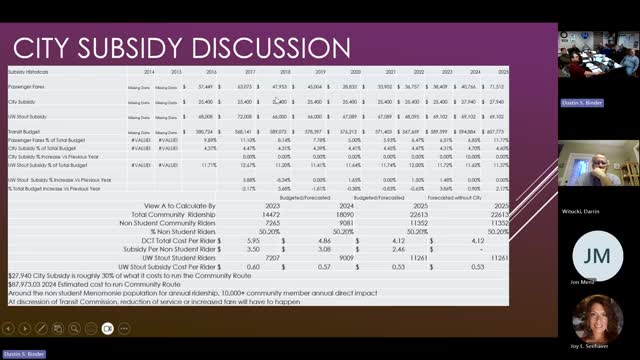Transit funding crisis threatens community bus services
November 08, 2024 | Dunn County, Wisconsin
This article was created by AI summarizing key points discussed. AI makes mistakes, so for full details and context, please refer to the video of the full meeting. Please report any errors so we can fix them. Report an error »

In a recent government meeting, officials discussed the financial dynamics of local transit services, highlighting the ongoing reliance on subsidies amidst rising ridership. The conversation revealed that while passenger fares have increased annually, subsidies have largely remained static, leading to a growing gap in funding.
The current subsidy, which amounts to approximately $27,940, covers about 30% of the costs associated with the community bus route, estimated to total around $88,000 for 2024. This funding is crucial, as the community route serves a significant number of riders, projected to exceed 10,000 next year, marking a 25% increase from the current year.
Despite the increase in ridership, officials noted a concerning trend: the budget for transit services has decreased in previous years, with only a recent uptick attributed to employee annual steps. The discussion underscored the potential impact of eliminating the subsidy, which could lead to drastic service reductions or fare increases that would undermine the route's affordability.
The meeting also touched on the operational costs, including manpower, fuel, and maintenance, which contribute to a projected deficit of 64% for 2023, expected to decrease to 52% in 2024. Without the subsidy, this deficit could escalate to approximately 80%.
As the transit commission prepares to address these issues at an upcoming city council meeting, officials emphasized the importance of maintaining affordable transit options for the community, particularly as ridership continues to grow. The conversation highlighted the delicate balance between funding, service provision, and the need for sustainable transit solutions in the face of financial challenges.
The current subsidy, which amounts to approximately $27,940, covers about 30% of the costs associated with the community bus route, estimated to total around $88,000 for 2024. This funding is crucial, as the community route serves a significant number of riders, projected to exceed 10,000 next year, marking a 25% increase from the current year.
Despite the increase in ridership, officials noted a concerning trend: the budget for transit services has decreased in previous years, with only a recent uptick attributed to employee annual steps. The discussion underscored the potential impact of eliminating the subsidy, which could lead to drastic service reductions or fare increases that would undermine the route's affordability.
The meeting also touched on the operational costs, including manpower, fuel, and maintenance, which contribute to a projected deficit of 64% for 2023, expected to decrease to 52% in 2024. Without the subsidy, this deficit could escalate to approximately 80%.
As the transit commission prepares to address these issues at an upcoming city council meeting, officials emphasized the importance of maintaining affordable transit options for the community, particularly as ridership continues to grow. The conversation highlighted the delicate balance between funding, service provision, and the need for sustainable transit solutions in the face of financial challenges.
View full meeting
This article is based on a recent meeting—watch the full video and explore the complete transcript for deeper insights into the discussion.
View full meeting
